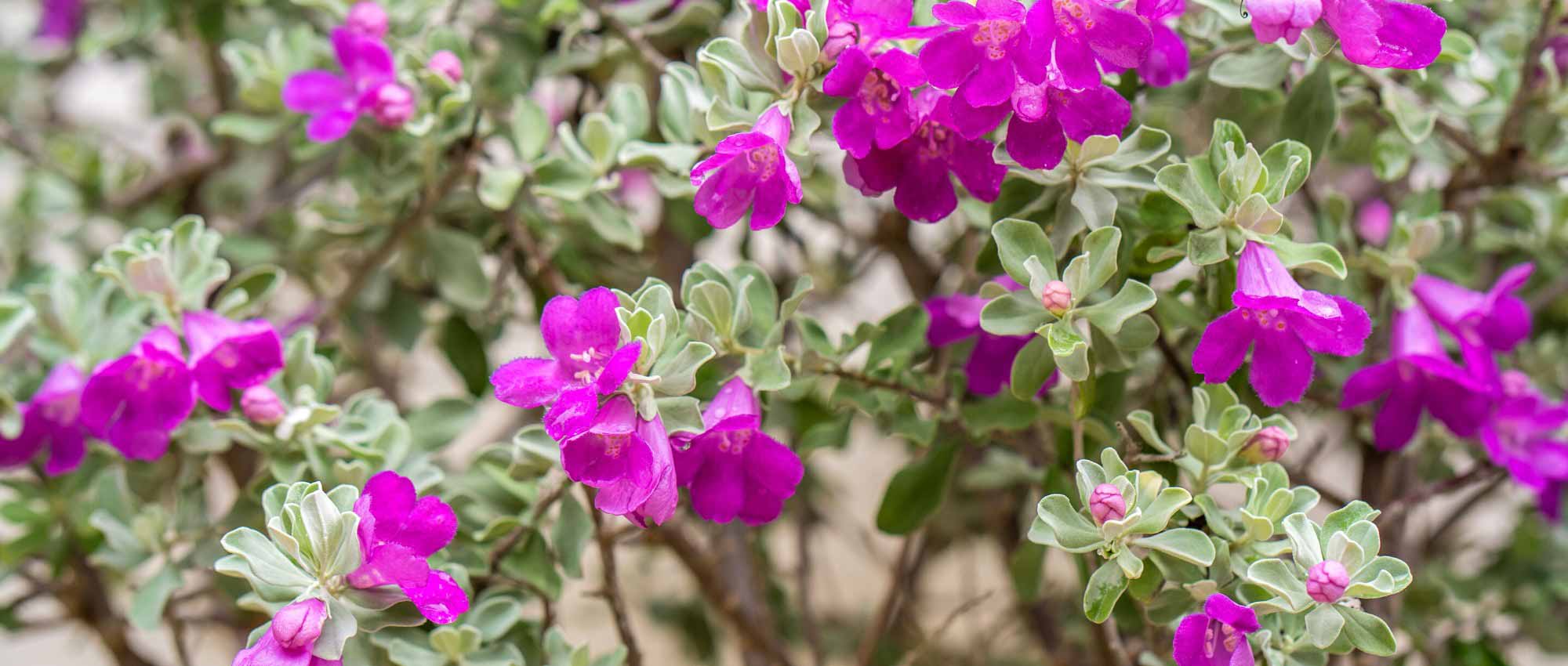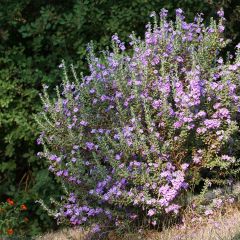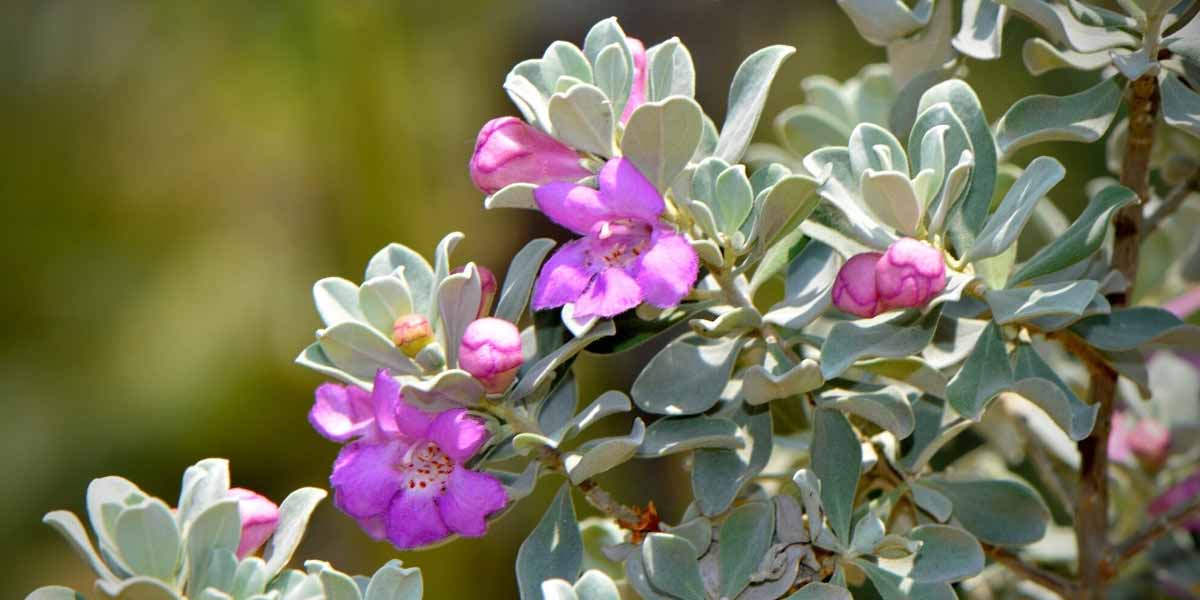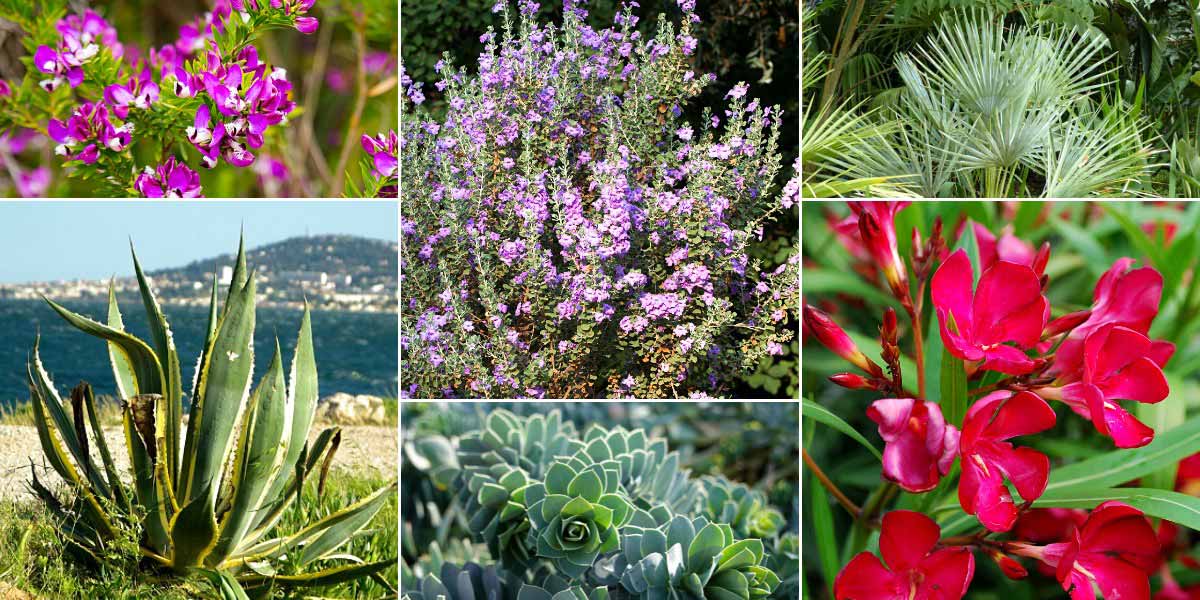
Leucophyllum: planting, growing, and caring
Contents
Leucophyllums in a few words
- The Leucophyllum is a compact and dense bush with silvery foliage
- In late summer to early autumn, it bears beautiful pink, mauve, or purple flowers
- Easy to grow, it is drought-resistant and requires very little maintenance
- Tolerant of salt spray, it adapts very well to coastal gardens
- It is perfect for rockeries, slopes, low hedges, or the back of borders, in well-drained soil
- This bush is ideal for a no-water garden!
The word from our expert
Nicknamed “Desert Sage,” Leucophyllums are little-known bushes, native to the desert regions of the southwestern United States and northern Mexico. They have a compact, dense, rounded habit and bear stunning silvery and velvety foliage. From late summer or early autumn, with the return of rains, they become covered in countless small pink, mauve, purple, or white flowers, depending on the variety. With their silvery foliage and colourful flowering, they are sure to bring brightness to flower beds!
These bushes are easy to grow in any well-drained soil, preferably dry and sandy. They thrive in sunny exposures and limestone soils. Once established, they are drought-resistant and require very little maintenance… in fact, when the summer is hot and dry, their flowering becomes even more spectacular! Tolerant of salt spray and salt, Leucophyllums are perfect for coastal gardens. They blend beautifully into rockeries, slopes, low hedges, or the back of flower beds, as long as the soil is well-drained.
Botany
Botanical data
- Latin name Leucophyllum sp.
- Family Scrophulariaceae
- Common name desert sage, Texas sage, Rio Bravo sage
- Flowering between August and October
- Height up to 1.50 m
- Exposure sunny
- Soil type well-drained, stony or sandy, neutral to alkaline
- Hardiness down to – 10 °C / - 12 °C
The Leucophyllum genus includes 19 species native to Mexico and the southwestern United States. They thrive in desert regions, earning them the nickname “Desert Sage.” They are still relatively unknown and rarely cultivated in France, despite being highly decorative with their silvery foliage and colourful flowers, as well as being easy to grow.
Although it is nicknamed “Desert Sage” or “Rio Bravo Sage,” the Leucophyllum is not a true sage (Salvia) and does not belong to the same botanical family (Lamiaceae). Instead, it is part of the Scrophulariaceae family, which includes mostly herbaceous plants, sometimes shrubby, with irregular flowers, typically tubular and bilabiate. This family also includes buddleias, diascias, nemesias, verbascums, and others.
The name Leucophyllum comes from the Greek leukos: white and phyllos: leaf, referring to its silvery foliage. The Leucophyllum langmaniae is nicknamed “Rio Bravo Sage,” referencing its geographical origin: the Rio Bravo, also known as the Rio Grande, is the river that marks the border between Texas and Mexico.
Interestingly, the Leucophyllum seems capable of predicting rain: it typically flowers just before rainfall, likely because it senses humidity in the air. In English, it is even nicknamed the Barometer bush.
The Leucophyllum forms a compact, dense, and rounded bush, reaching 1 m to 1.50 m in height and about 1 m in spread at maturity. In the garden, it can be used as a low hedge or in a shrub border, and it tolerates pruning very well.
It flowers in late summer or early autumn, and becomes covered with countless small flowers, which appear in the axils of the leaves. They come in shades of pink, mauve, purple, or white, depending on the variety. The flowers have a tubular or funnel shape, opening into five lobes (corresponding to the five fused petals), arranged in two lips (two lobes close together at the top and three at the bottom). They measure 2 to 3 cm in all directions.
Typically, the flowers appear in successive waves, depending on rainfall. However, if the summer is marked by prolonged drought, the flowering will be singular and brief but more spectacular!
The flowers are melliferous, attracting pollinating insects that come to forage.
After flowering, the Leucophyllum produces small capsules, dry fruits that open at ripeness to release the seeds they contain.

The flowering of Leucophyllum frutescens, Leucophyllum langmaniae, and Leucophyllum laevigatum (photos: Forest and Kim Starr / Stan Shebs)
In addition to its flowering, the Leucophyllum is appreciated for its dense foliage and beautiful silvery hue, which is very luminous. This colour is due to the countless tiny white hairs covering the leaves. Living in desert regions, the silvery foliage of the Leucophyllum is an adaptation to heat and drought: it reflects sunlight and traps moisture in the small hairs covering the epidermis, reducing water loss.
The leaves have a rather ordinary shape, being ovate to oblong, and measure about 2.5 cm in length.
The Leucophyllum frutescens is evergreen, retaining its foliage year-round, even in winter.
In addition to being ornamental, its leaves can be consumed as an infusion. They are believed to have hepatoprotective properties.

The silvery foliage of Leucophyllum frutescens (right photo: Forest and Kim Starr)
The main varieties of Leucophyllum
The Most Popular Varieties

Leucophyllum frutescens
- Periodo di fioritura October, November
- Altezza a maturità 1,50 m

Leucophyllum langmaniae
- Periodo di fioritura September to November
- Altezza a maturità 90 cm
Planting
Where to Plant?
A plant of warm and dry climate, the Leucophyllum will thrive if you place it in a sunny spot, facing south. It is also important that the soil is very well-drained, sandy or stony, and preferably slightly alkaline. If your soil tends to retain water, do not hesitate to add some coarse sand or gravel, and plant it at the top of a slope, on a mound or embankment, so that the water drains easily. The Leucophyllum can be planted in a rock garden or atop a stone wall, and it is perfect for dry gardens without irrigation. Tolerant of salt and sea spray, it can easily be planted near the coast. Finally, it is also suitable for creating a low hedge, alongside other bushes, or at the back of a flower bed, as long as the soil is well-drained. It can also be grown in a large pot with a well-draining substrate and placed on a terrace or balcony.
When to Plant?
We recommend planting the Leucophyllum in spring, around April, unless you live in the south of France, under a warm and dry climate: in this case, it is better to plant it in autumn, so it can benefit from milder temperatures to establish itself.
How to Plant?
In the ground:
- Dig a planting hole, at least twice the size of the root ball.
- Optionally, mix some coarse sand and gravel into the planting soil to improve drainage.
- Plant the Leucophyllum, placing it right in the centre.
- Fill in by replacing the substrate around it, then lightly firm the soil.
- Water generously.
- You can add a layer of mineral mulch at its base.
- Continue to water it regularly in the months following planting, until it is well established.
In a pot:
- Choose a large pot with drainage holes.
- Place a small layer of gravel, broken pottery, or clay pebbles at the bottom.
- Add a well-draining substrate, such as a mix of compost, coarse sand, and garden soil.
- Carefully remove the Leucophyllum from its original pot and place it in the new pot, centred.
- Fill in by adding more substrate.
- Lightly firm the soil.
- All that’s left is to water it.

Leucophyllum frutescens
Maintenance
We recommend watering the Leucophyllum during the first year of cultivation, until it is well established and develops its root system. After that, water only during prolonged dry spells.
Naturally dense and rounded in habit, the Leucophyllum can easily do without pruning. However, if you wish to maintain a compact and regular shape, you can carry out light pruning in autumn, after flowering.
Once well established (after two to three years), the Leucophyllum can tolerate temperatures of around -10°C to -12°C, provided the soil is well-drained. In case of severe cold, especially in the first few years, cover it temporarily with winter fleece and remove it as soon as temperatures rise.
If you grow the Leucophyllum in a pot, we recommend watering it occasionally, as the substrate will dry out faster than in the ground. For winter, you can move the pot to a sheltered, bright but unheated location.
The Leucophyllum is rarely affected by diseases or parasites.
Multiplication
Propagation by Cuttings
The Leucophyllum can be easily propagated by cuttings from herbaceous or semi-woody stems in summer.
- Choose and then take a healthy stem, about 10 cm long. Cut just below a node (the point where leaves attach to the stem).
- Remove the leaves from the lower part of the stem, leaving only a few at the tip.
- Prepare a pot by filling it with a light, well-draining substrate, ideally a mix of compost and coarse sand, then water it.
- Dip the base of the stem into plant hormone for cuttings.
- Make a small hole in the substrate using a thin stick or pencil, then plant the cutting in it.
- Optionally, place a plastic bottle over the pot to create a humidity-saturated environment (propagation under cover). Ensure occasional watering and prevent the cutting from touching the walls to avoid rotting.
- Place the pot in a sheltered spot, somewhere bright but out of direct sunlight.
For more information, feel free to check out our complete guide on propagation by cuttings.
Association
Leucophyllum will easily integrate into a Mediterranean-style garden, especially since it tolerates salt and sea spray without issue, making it ideal for coastal planting. It pairs perfectly with other dryland plants such as lavender, euphorbias, rosemary, delospermas, and helianthemums. It will particularly complement the flowering of Polygala myrtifolia, which, like the Leucophyllum, boasts beautiful mauve blooms. Also consider agapanthus, myrtle, Ceanothus ‘Autumnal Blue’, and Escallonia ‘Crimson Spire’… Finally, add a touch of exoticism with the finely cut foliage of a palm such as Chamaerops humilis ‘Cerifera’.

Polygala myrtifolia, Leucophyllum langmaniae, Chamaerops humilis ‘Cerifera’, Agave americana ‘Variegata’, Euphorbia myrsinites (photo: Guilhem Vellut), and Nerium oleander
Leucophyllum can also simply fit into a dry garden or rockery, alongside sedums, houseleeks, opuntias, eryngos, and agaves. Add lightness by interspersing clumps of ornamental grasses (Stipa tenuifolia, Pennisetum, Festuca glauca…). Also consider the colourful blooms of carnations, mulleins, and catmint. You can also highlight Leucophyllum by pairing it with other silver foliage, such as that of Stachys byzantina, Salvia argentea, and Senecio cineraria.
Also worth reading
- Discover our full range of bushes and perennial plants for dry soil
- Our article “10 drought-resistant perennial plants for a garden without watering”
- To pair with Leucophyllum, explore our inspiration page “Dry Terrain”
- Subscribe!
- Contents































Comments